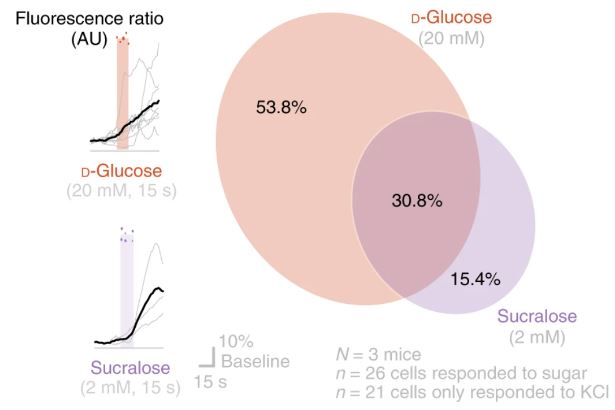Tricks or Treats
By Kirsten Giesbrecht
Our guts differentiate between sugar and artificial sweeteners.
October 25, 2022
From The Staff Biology Anatomy
Between caramel apples, Halloween candy, and pumpkin-flavored beverages, fall offers a smorgasbord of delightful treats. If you indulge in an apple cider donut, you’ll probably be aware of how your sense of smell and taste affect your experience. But these aren’t the only senses you’re using as you enjoy your confection. There are other, less obvious senses, such as your gut sense, that might urge you to reach for a regular instead of a sugar-free candy bar. Maya Kaelberer, assistant professor at Duke University, discovered how the gut tells the brain if you’re consuming sugar or a zero-calorie sweetener. Kaelberer spoke at the September 2022 Science by the Slice lunch hybrid event hosted by Sigma Xi, the Scientific Research Honor Society (Sigma Xi is American Scientist's publisher). Watch the recorded talk below or scroll down to the end to view the Twitter thread of talk highlights, authored by Imani Vincent, an intern with Science Communicators of North Carolina.
Driven to understand how our perception influences the way we think and react, Kaelberer earned a dual degree in psychology and neuroscience as an undergraduate at the University of California, San Diego. Kaelberer wanted to continue studying sensory systems in graduate school at Yale University, but instead of studying a sense such as sight or smell, she studied the visceral sense and the vagus nerve. Vagus, meaning wandering in Latin, is an apt name for this nerve, because it connects the brain to many internal organs including the lungs, heart, and gut, and weaves between them.
In 2018, as a postdoctoral researcher at Duke University in Diego Bohorquez’s lab (who previously spoke in this seminar series), Kaelberer discovered a direct connection from the gut to the brain through the vagus nerve. Lining the gut are millions of fingerlike protrusions called villi, which absorb nutrients from the food. On the surface of each villi are a variety of cells, including gut sensory cells called neuropod cells. Kaelberer showed that a neuropod cell detects physical forces, chemicals, and nutrients, then translates these physical cues into electrical signals through the vagus nerve to the brain. This translation of physical force detected in the gut into an electrical signal interpreted by the brain occurs very rapidly. In the wake of this astounding discovery remained one glaring question: What could the gut possibly be telling the brain that the nose and tongue couldn’t?

Image courtesy of Maya Kaelberer.
At the same time, Kaelberer and her colleagues were studying sugar and artificial sweetener preference in mice and noticed something strange. Unsurprisingly, mice strongly preferred sugar to a zero-calorie sweetener, such as sucralose. However, mice still chose sugar over artificial sweetener even without taste buds. Kaelberer realized that if mice weren’t distinguishing sugar from sucralose with their sense of taste, they must be using a different sense to differentiate between sweet substances. So she began investigating the circuitry of the gut sense.
First, Kaelberer checked whether the vagus nerve could distinguish sugar from sucralose. When the vagus nerve responded similarly to both sugar and sucralose, it became clear that the vagus nerve wasn’t the cause of the differentiation. Next, Kaelberer shifted her focus to the gut, where she exposed neuropod cells to either sugar or sucralose. More than half of the neuropod cells responded to just sugar, about a third of them couldn’t tell the difference between sugar and sucralose, and the remaining 15 percent responded to only sucralose. Kaelberer’s data showed that instead of taste buds in the mouth favoring sugar, it’s the neuropod cells in the gut. Indeed, the vagus nerve obtains sweetener information exclusively from the neuropod cells: When neuropod cells were blocked, the vagus nerve no longer responded to any sweetener.
But what makes some neuropod cells sensitive to sugar and others to sucralose? It boils down to what type of receptors and transporters are embedded in the membranes of the neuropod cells. If the neuropod cells have lots of sweet-taste receptors, they are sensitive to sucralose. If instead they have sugar transporters, the neuropod cells respond to sugar, because sugar can be transported and used by cells for energy whereas zero-calorie sweeteners can’t. Soon Kaelberer and colleagues realized it wasn’t just two different types of neuropod cells involved in the gut sense, and uncovered two completely parallel pathways for sensing sugar and sucralose in the gut-to-brain communication path, beginning with the neuropod cells. Upon encountering sugar, a sugar-sensitive neuropod cell with sugar transporters will release the neurotransmitter glutamate to a specific population of neurons. If a sucralose-sensitive neuropod cell with sweet-taste receptors encounters sucralose, then the energy molecule ATP will be released to a separate population of neurons. Even though our taste buds may not detect a difference, sugar and sucralose interact with two distinct casts of cells and molecules, separate neuropod cells in the gut with different receptors, chemicals, and neurons involved.
Armed with this new understanding of the two separate circuits, Kaelberer suggests that we can develop low-calorie options that would both contain artificial sweeteners and be designed to trigger glutamate release, for a sweet snack with minimal sugar. She also suggests these findings can be used to inform nutritional psychiatry, the study of how our diets can influence our thoughts and moods. She adds, “Food affects how we feel, we just don’t know the circuitry.” Her research on the circuitry for communicating about sweet substances between the gut and brain can pave the way for similar research. “The gut has to be the first sense,” says Kaelberer, adding that, “The most primitive nervous systems are just gut nervous systems. They’re just sensing the gut moving food through, and from there everything else evolves.” She likens the gut nervous system to a bicycle. If we know how this simple wheeled machine works, we can build upon that concept for understanding how a car works. If we understand the basic sensory transduction system of the gut to brain circuits, we’ll have a blueprint for how these circuits evolved for higher cognition. By learning about how the gut senses and communicates to other organs, we can gain a deeper understanding of nervous systems fundamentals and sensory circuit evolution.
Tweets highlighting the talk follow below.
This blog was produced in collaboration with Science Communicators of North Carolina.

American Scientist Comments and Discussion
To discuss our articles or comment on them, please share them and tag American Scientist on social media platforms. Here are links to our profiles on Twitter, Facebook, and LinkedIn.
If we re-share your post, we will moderate comments/discussion following our comments policy.